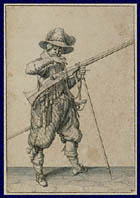|
During the period known as the Golden Age of Dutch Art, a tremendous increase in artistic activity coincided with momentous changes in Dutch political and economic life. In 1648, after nearly a century of struggle, the Dutch won their independence from Spain. As the new Dutch Republic became more prosperous, its art market grew rapidly.
This exhibition shows Dutch artists looking at their own landscape and people for inspiration in a period in which their drawings were increasingly valued as independent works of art.
|
 |
|
The Dutch independence from Spain engendered a pride in the native countryside. Here Rembrandt depicted several distinctive aspects of the Dutch landscape—an open expanse of water, a low sky, a flat view of land, and church steeples in the far distance. Both within Holland and on the sea, boats were essential to Dutch commerce.
|
 |

 |
 |
A Soldier on Guard Blowing
the Match
|
 |
 |
Crucial to Dutch independence from Spain was military reform. As part of this effort, political leaders commissioned Jacques de Gheyn II to produce a series of engravings called Exercise of Arms. Here De Gheyn illustrated step forty: how the musketeer should balance his matchlock musket on a rest as he blows on his match.
|
 |
|
This Dutch landscape was executed on Japanese paper, demonstrating how artists benefited from the foreign goods that were imported to Holland with the expansion of Dutch trading routes and colonial ambitions. Lievensz's use of such costly paper suggests that he produced the drawing itself as a commodity.
|
 |
|
Cattle-breeding and dairy industries became sources of Dutch national income and pride during the fight for independence. Artists developed the category of animal paintings to celebrate Dutch dairy products such as cheese, butter, and milk. Van de Velde reportedly made frequent ventures into the countryside to sketch cattle, and his sensitive portrayal shows the animal as an individual being, not just a source of milk.
|
 |
|
Van de Venne's grisaille paintings and drawings—works executed in subtle tones of the same color—tend to focus on human folly and are often moralizing in tone. The subject matter of this nocturnal scene, however, is not clear. The unflattering depiction of the old woman smoking a pipe may be interpreted as a condemnation of her licentiousness. The man's bagpipes, often a symbol of sexual prowess, might also suggest immoral behavior.
|
 |